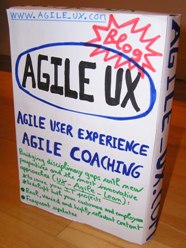Posted by jc-Qualitystreet on 2011/02/08
The question arises regularly… so here’s my own definition of agility:
« Agility is the ability of an organization to create value and to continuously delight the customer, while promoting and responding to change in its environment »
This broader definition completes a recent quote of my fellow french blogger Claude Aubry* on Twitter, and adds to Jim Highsmith’s definition ( »Agility is the ability to both create and respond to change in order to profit in a turbulent business environment » 2002) or Craig Larman’s definition (« Rapid and flexible response to change » 2004). While I found these good definitions very inspiring, I was missing something…
I was missing the CLIENT, the primary goal and core foundation of an organization, the means to align employees to a common vision and the key differentiator against competitors. Indeed, in today’s world of complexity and competition, the challenge is not only to deliver value early but mostly to continuously delight his primary customer.
This is the only viable purpose to be successful in the long term. For this, the agile organization must be both proactive, active and reactive, supported both by lean, agile and user eXperience practices.
Of course « being agile » is also a mindset based on core values: communication, feedback, courage, simplicity, respect and the four from the Agile Manifesto.
* « L’Agilité est la capacité d’une organisation à créer de la valeur, tout en s’adaptant -à temps- aux changements dans son environnement » 2010
Posted by jc-Qualitystreet on 2011/02/01
The product backlog is a prioritized list of everything that might be needed in the product. This is the thread of a Scrum Agile project.
My Product Backlog is DEEP…

My Product Backlog is DEEP…
The acronym D.E. E. P. (detailed appropriately, estimated, emergent and prioritized) summarizes key attributes of a good product backlog.
Unfortunately among agile teams, few product backlogs now meet these criteria, but surprisingly (or not), the question of the tools to manage it seems to be more « exiting » … From dedicated tools, to Excel or Google spreadsheet; from Sharepoint to Jira or even QualityCenter 🙂 … which tool to choose? That’s forgotten pretty quickly, another key characteristic of the product backlog: its physical aspect!
My Product Backlog is DEEP… and PHYSICAL
Having a physical version of the product backlog, visible and easily accessible is crucial. Associated to the burnup chart, it’s a key element within the information radiator of the project.

We see the end!
Indeed, unlike a virtual (electronic) product backlog, the physical product backlog:
- offers to everyone (belonging to the Scrum team or not) a real time visibility on the progress of the product development: what we’re doing, what we did and what we need to do to finish the product;
- is a strong sign of transparency and openness
- gives a meaning to the work of the team (source of motivation and engagement);
- provides each team member with a clear idea of the big picture.
An agile state of mind and some prerequisites
The cost of initialization of a physical product backlog (for example the writing effort) is minimal. However, its effectiveness requires that:
- the physical product backlog belongs to the information radiator located where the team works (closed to the Product Owner in a collocated environment);
- the physical product backlog becomes a real meeting point for the team and the Product Owner;
- the product backlog is groomed and managed continuously: leaving a product backlog abandoned in a corner of the wall is the sign that something goes wrong.
Obviously, electronic versions of the product backlog remain essential for distributed teams operating in remote environments. Yet even in these contexts, a return to simplicity and value is often useful. Tools must only exist to make processes more efficient and to facilitate the work of people.
So a virtual product backlog tool should remain a source of value, and should be neither a constraint nor a waste.
Posted by jc-Qualitystreet on 2011/01/29
Marketing teams now who want to become Agile…
At Valtech (FR), marketers have already taken the opportunity to adopt agility in their own business.
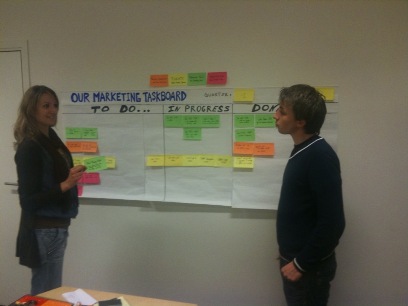
- AgileMarketing-The Daily Scrum
The team is small. Agile planning and visual management around a « beautiful » taskboard are the first agile elements the team wanted to experiment.
Every day in the morning, no more than 10 minutes, the team does its « Daily Scrum » to synchronize, measure progress and identify impediments. For them, Agile is a good way to work together and to build a relation of trust based on FEEDBACK, TRANSPARENCY and RESPECT.
And you know what? They like it!
Posted by jc-Qualitystreet on 2011/01/21

A very good ROTI given by the participants!
User Story Mapping, Vision, Personas, Specifications Workshops, Guerilla Usability and more … all the activities of the Agile UX practitioner during these two days of training.
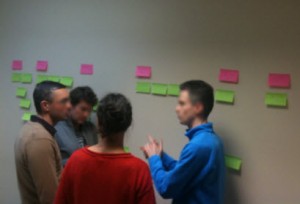
User Story Mapping Workshop
the opportunity for participants to return to foundations (both Agile and UX) but also to learn new techniques, new practices …
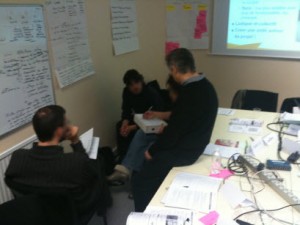
Product Vision Box Workshop
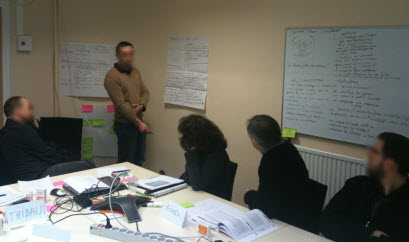
Participant introducing a "pragmatic" persona: Raoul !
the opportunity for a heterogeneous group, composed of 7 Agilists and 3 Usability consultants, to discover each other, learn to work together and ultimately find that Agile UX collaboration works!
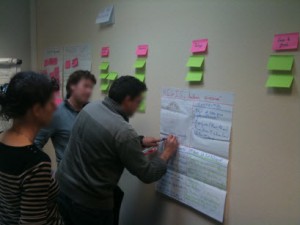
"Regis": a pragmatic Persona under collective construction
In short a great class and a real pleasure to do the training !
More information on this training session (in french)
Posted by jc-Qualitystreet on 2010/12/23
Agile marketing is a new mindset for marketers who adopt agile principles and practices in their daily activities (agile Marketing taskboard: why marketers love it?)
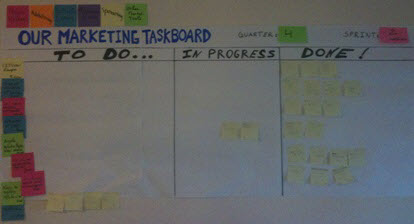
Agile Marketing Taskboard for Marketers
But Agile marketing is first the realization of IT projects for marketing using agile development This kind of project can only succeed and flourish in short cycles, with frequent deliveries, lead by FEEDBACK and open to change.
As pointed out recently Lubomira Rochet (Valtech), proposing the right product to the right person in the right context at the right time is key for digital marketing and to secure competitive advantage in a world where everything is accelerating.
To achieve it, the future of marketing will be primarily to deliver early, to test, test again and again, measuring and continuously adapt. A set of activities very closed to the Kaizen principle (continuous improvements), pillar of Lean thinking, and finally the real challenges which only an agile and lean approach can face with effectiveness and efficiency.
Good… but the agile marketing dynamics doesn’t come without impact and requires reflection.
Impact of Agile marketing 1… Undeniable benefits for Marketing and Business in general…
- Align IT and Business to the same Vision and objectives
- Deliver early and often to get the maximum of value and feedback
- Improve team morale, motivate and engage people
These are the major advantages of agile marketing but not only…
- enhancing the ability to influence the progress of the project, including changing priorities, better managing emerging needs and adapting to an environment of change (via an emergent product backlog);
- improving project visibility through visual management and extensive information radiators
- accelerating time to market through a single objective: getting the most valuable elements as soon as possible;
- getting a better adaptation to user needs through numerous opportunities for feedback, earlier and more frequent interactions, demonstrations and regular deliveries to meet new requirements (Test – Measure – Adaptation)…
are other benefits of agile marketing.
Impact of Agile marketing 2… Duties and the necessity to collaborate…
- Bring EVERYBODY TOGETHER, IT and Marketing, and establish an environment of trust
- Facilitate COOPERATION and foster effective COLLABORATION throughout the project (from the beginning to the end)
- Bring out a new role: the Product Owner with a set of responsibilities
- Empower teams
- Cut projects in short sprints (with a duration of 1 week, 2 or 3 weeks …)
- Establish a delivery cadence
- Test, Test, Test… Inspect and Adapt!
- Do just enough formalism, procedures and seek to eliminate wastes at all levels
Impact of Agile marketing 3… continuous reflection on a delivery cadence
On one hand, delivering earlier and more frequently can generate more revenue (new billing conditions, customer retention or acquisition …).
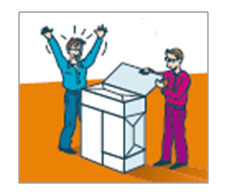
A successful Delivery !
It is also quite suitable for digital marketers that need to test again and again various options and multiple configurations to optimize their conversion rates, to meet user needs, or simply create effective « landing pages ».
On the other hand (and other contexts), switching from one to several releases a year entails additional work. It has a cost and must be prepared. Moving from 1 to 4 releases a year like SalesForce or going to 45 releases like PatientKepper is not easy task. Cost and technical considerations are crucial but other factors should be taken into account:
- The involvement and availability of teams (development, business, support, sales, operations)
- The synchronization effort required
- The capacity to work frequently on the required deployment artifacts
- The willingness of the users to change their habits, to learn new functions, to reinstall applications, to acquire new licensees
- The balance between the desire to initiate a continuous conversation with its users by offering them as regularly as possible new features and the risk of losing these innovations in the mass of multiple announcements about the Product .
- The natural rhythm of the market
So, agile marketing is challenging and involves coordination of many people. Great benefits can be expected but impacts inside or outside the organization don’t have to be underestimated.











